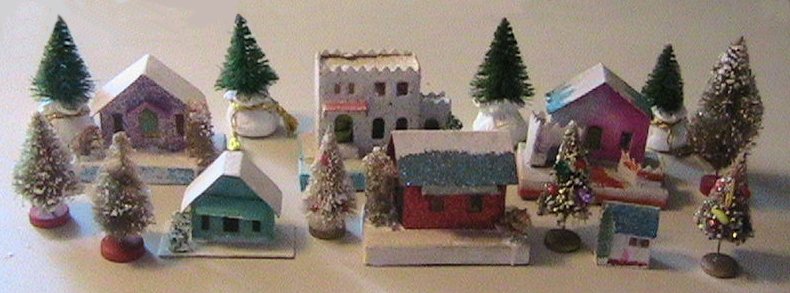|
|
The History of Cardboard Christmas (Putz) Houses:
 Welcome to Cardboard Christmas Past! Welcome to Cardboard Christmas Past!
Christmas villages in one shape or another have been around for centuries. But cardboard Christmas houses have only been around 130 years or so. And cardboard Christmas houses made to glow from electric light bulbs have only been around since about 1928, when electric light strands, became affordable for the average family. 
Why is the term “putz” applied to these houses? Because German-speaking Americans incorporated them into a long tradition of setting up Christmas villages around their nativities (and sometimes their Christmas trees). The word “putz” has a literal meaning of “put,” but in German-American culture, it can mean “putter,” as in “How long are you going to keep putzing around with those houses?”
Between 1880 and 1928, most cardboard Christmas (putz) houses were actually candy boxes, and there have been many delightful examples of those. But the real revolution came when the manufacturers (mostly Japanese) started putting holes in the back of houses for C-6 light bulbs.
After that, there was an explosion of variety, mostly from Japanese designers whose names were, sadly, never recorded, but who produced many remarkable pieces - even more remarkable since so many sold for five or ten cents. Japan’s near-monopoly on these houses was interrupted by World War II, but North American companies like Dolly Toys created their own versions, working around wartime limitations on things like cellophane and even ink.
Though imported putz houses reappeared after the war, America’s love of these little houses and the communities they created eventually waned, when other interests, like television, consumed the time - and the space - that families used to spend setting up, and rearranging (putzing around) the little houses and accessories.
Thankfully, a few collectors have seen value in protecting, cataloging, and researching cardboard Christmas houses before all the examples disappeared or fell apart from neglect. Collector and self-taught historian Ted Althof stored as much history as he could find on his “Papa Ted’s Place” web site, which also came to serve as a sort of clearing-house for information that others could share as well. Thanks to Ted and his contributors, we actually know far more about these little houses than most families who set them out when they were new. Sadly, Ted passed away in October, 2012, several months after asking us to maintain an archive of his site here. Because Ted’s work is still the single best source for information on many aspects of putz house history, we include several links to the archive in the list below.
History pages you should find useful include:
We will be adding other pages as time permits, but these should give you a very solid background as you start collecting or building your own cardboard Christmas houses.
|
|